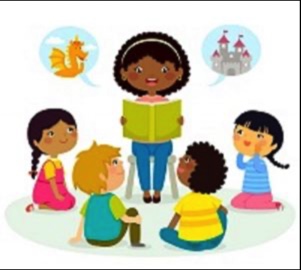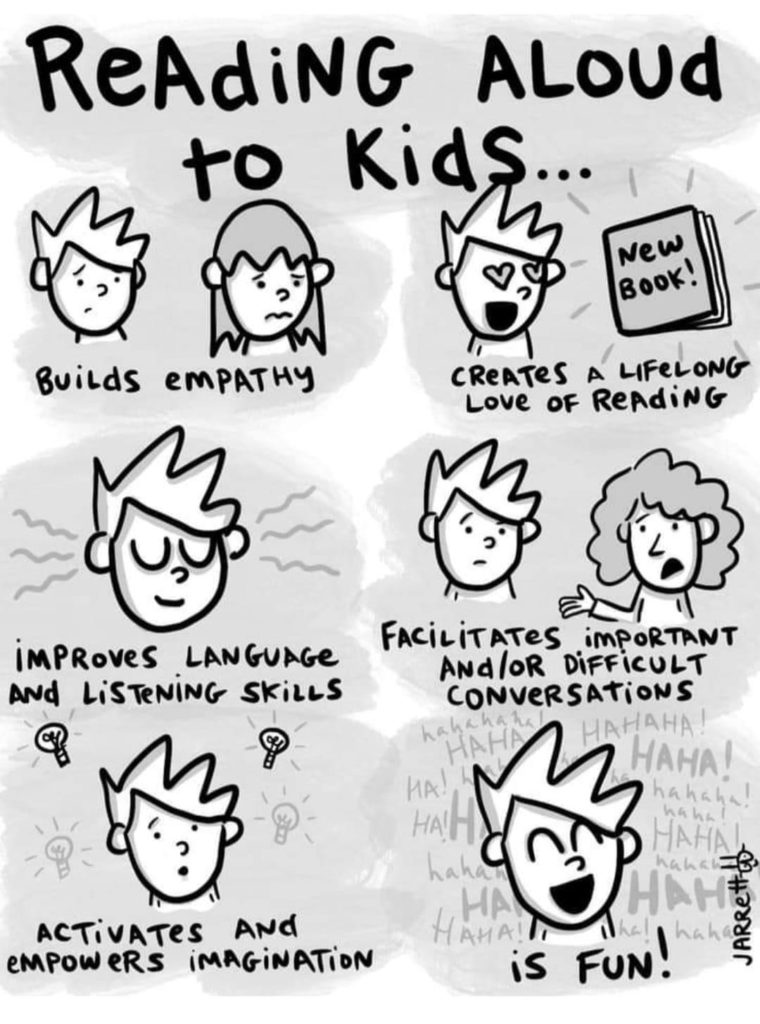
Should You Read Aloud to Your Kids?
It was an ordinary afternoon. I was reading the last few chapters of a book to my kids. I wanted to finish the book before my sister-in-law arrived, but I was having a hard time getting through it. I kept stopping because I was crying. I tried to pass the book on to one of the kids but they refused. So I kept at it. I still had a few pages left when the doorbell rang. My sister-in-law came in and listened while I finished–tears and all. This is actually a common scene in my house–mom crying while trying to read aloud. But I keep doing it. I believe in the power of reading aloud and won’t let a few tears stop me.
I wasn’t much of a reader as a kid. I read if it was required and sometimes read fluff for fun. My only memory of my parents reading to me is of my dad re-telling one of his favorite stories–The Hobbit–over and over. My mom says she read to us when we were little, but I don’t remember. I do remember a couple of my elementary school teachers reading aloud to us–James and the Giant Peach in 3rd grade and Johnny Tremain in 5th grade. So, I find it surprising that I enjoy reading so much now as an adult. Part of the joy I find comes from sharing books with my kids through read alouds. I’ve been reading aloud to them since my oldest was a baby. It started with board books, then picture books, then audio books in the car, to chapter books before bed, to our daily read aloud time every morning. I’ve seen the benefits of almost 20 years of reading aloud.

One of the benefits is that reading aloud connects and bonds families and creates memories. In the book “The Read-Aloud Family” by Sarah Mackenzie we learn that the primary goal of reading to children–and of teaching them to read–is not so they can eventually learn to read on their own, but to connect them with their families. Sarah quotes Jim Trelease, author of “The Read-Aloud Handbook”. She says “his book is chock-full of statistics and data that prove reading aloud connects and bonds families and helps kids grow to be successful in just about every area of life, especially in school…He asserts that read-alouds are the foundation for the close bonds between parents and kids, between teachers and students.”
My husband has a memory from his childhood about piling onto his parent’s waterbed with his siblings and listening to “Amy’s Eyes”. The experience stuck with him so much that he wanted to read it to his kids. By the time our kids came into the picture, the book was out of print. He had to search for it, but eventually found it and shared that childhood memory with his new family.
I loved it when one time I was reading “Little Women” to my middle daughter. We were at the kitchen table and my older daughter was supposed to be at the piano practicing. Eventually the piano would stop or get quiet and I knew she was listening. Little Women is a favorite book of hers too and she wanted to be part of the experience. Plus it’s another book that I can’t get through without crying.
When I asked my kids for their favorite read aloud memories they all said laughing at mom when she cries. One loves reading over my shoulder while I read. They all remember laying on the floor in a circle while I read a picture book. They remember referencing books in games because we all share a common language. My youngest remembers all going to bed at the same time so that I could read aloud in the hallway. My oldest remembers when I would insert the names of my kids as I read to get their attention or teach a lesson.
Because I didn’t read a lot when I was kid, I enjoyed experiencing books for the first time with my kids and creating new memories around those stories. Classics that most children read in elementary school, like “The Mixed-up Files of Mrs Basil E Frankwhiler”, “A Wrinkle in Time”, “The Witch of Blackbird Pond”, and “Winnie the Pooh” became family favorites. “The Giver”, “The Chronicles of Narnia”, and “The Little House on the Prairie” series were books that we would read regularly and learn something new each time.

Someday I hope my children will come across a book in a book store or garage sale and remember when I read it to them and smile at the memory. They may not remember the exact story, plot line, or characters of the book, but they will not forget that their mom read to them. As Sarah Mackenzie said in her book, “These moments will live on in our children’s hearts even when our kids no longer live in our homes.”
In “The Read-Aloud Handbook”, Jim Trelease suggests that the academic benefits alone of reading aloud are so great, if someone invented a pill to deliver those benefits, there would be a line for miles and miles to get it. Parents would fall over themselves and pay enormous amounts of money to give their kids the benefit of the pill. The 1985 Commission on Reading declared, “The single most important activity for building the knowledge required for eventual success in reading is reading aloud to children. Reading to our kids teaches them to think, make connections, and communicate.” Dr. Catherine Pakaluk tells a story of how her literature-rich education helped her think, make connections, and communicate while getting a science degree. She attended a highschool that had a big focus on literature but was light on math and science. She worried that she wouldn’t be prepared for her future schooling and career in the science field. She attended college at Harvard and felt at a disadvantage to the other kids who came from high schools with math and science programs. After a few weeks, though, all the students were at the same place–drowning or barely staying afloat. After a few more weeks the tables turned and classmates were coming to Catherine for help. They wanted to know how she was doing so well with her lab reports and write-ups. She had been convinced that a math and science based education would better suit her goals and was frustrated at the large amount of reading and literature required to do. She said, “I eventually found that reading literature does this thing to your brain, to the way you think about information, which is inherently superior to mastering recipes of skills. I was able to take a set of skills which I had not formerly applied to science and scientific inquiry, and succeed much more easily than my peers who had only spent their high school years mastering scientific content.” She was able to apply those skills to a subject outside of language and literature.
Kids who are read aloud to tend to have a bigger vocabulary, better grammar, and good reading comprehension. My kids attribute their writing skills to the amount of books we’ve read together. I’m also a firm believer that all my kids learned to read because I read often to them.
My favorite benefit of reading aloud is that reading begets reading. All of my kids enjoy reading. One of the first books my oldest boy chose to read on his own was The Hobbit. You can often see one of them with headphones in listening to an audio book, cuddled up on the couch or their bed with a paperback or ebook, reading to learn about a subject of interest, or lugging a book to an activity where they know there will be down time. Sarah Mackenzie says that falling in love with books, “cultivates a natural curiosity to find out what next or what else, gives them momentum to read more, and helps them encounter new ideas and make better connections.” Falling in love with reading is an affection that will serve them their entire lives.

Stories allow us to live vicariously through the characters and learn lessons of empathy and compassion. Sarah Mackensie says, “When we read aloud, we give our kids practice living as heroes. Practice dealing with life and death situations, practice living with virtue, practice failing at virtue. As the characters in our favorite books struggle through hardships, we struggle with them. We consider whether we would be as brave, as bold, as fully human as our favorite heroes. And then we grasp–on a deeper, more meaningful level–the story we are living ourselves as well as the kind of character we will become as that story unfolds.”

While reading “When the Men Were Gone” we felt what it was like to be a woman in the 40s. We experienced bullying and child abuse from Doug in “Okay for Now”. We learned how siblings take care of each other and their neighbors from the Vanderbeekers. We wonder how we would treat Auggie or Melody–two children from different books with disabilities. We go on adventures with Josef as he climbs the Citadel in the Alps, or Gregor as he falls into the underland, or the Pensives as they walk through the wardrobe. We learn with Louis L’amour as he travels the country getting an education and cry with Anne as she loses her adopted father. Books let us live and learn some lessons that we just can’t learn on our own.
Books also help us teach our children truths. “As parents there is so much we need to teach our children,” Sarah Mackenzie says. “There are lessons to impart–wisdom and insights to offer before our kids launch into the world on their own. But a didactic lesson or reprimand from mom or dad will only go so far. There is simply no substitute for story. When it comes to imparting truth to our kids, nagging lectures from an adult simply can’t compare with a story whose time has come. A story meets the child where he is. It sparks an authentic desire within him to do better, try harder, and love more. It allows each of our kids a vicarious experience, giving them the precious gift of practice.“
I love stories that teach a lesson and help us become better. Books like “Huck Finn” and “To Kill a Mockingbird” teach our kids to love people for who they are. “A Bad Case of the Stripes” teaches us to be comfortable with who we are. We learn from “Laddie” how to be a man and how to not judge from “Trouble”. Books are powerful ways to experience things.
Not everyone has the habit of reading aloud to their kids. Here are a few things you can do to include reading aloud in your day and to set yourself up for success.
Start with reading books that are enjoyable for you. When we graduated from picture books to chapter books (though we never really stopped reading picture books), the first books I read were stories that I knew would be fun–”Tales of a 4th Grade Nothing” and “Ramona Quimby”. I wasn’t thinking about the message, I just wanted us to enjoy the experience. Then I tried books that were fun and taught us important lessons. I used read aloud time to introduce books to my kids that I knew they wouldn’t pick up on their own–some of the more difficult classics like “Treasure Island” and books by Charles Dickens. I also wasn’t afraid to put down a book that I didn’t like. We started “Scarlet Pimpernel” three times before we actually made it all the way through. My most recent favorite type of book is Middle School books. There’s something about the lessons learned, the master teachers and mentors, and the friendships made.

Make reading aloud easy to do. Attach it to something you are already doing. Meal time or bedtime happens every day. We have our read aloud time as part of our devotional every morning. Use audio books in the car when you have a captive audience. You can also use the empty slots of your day to read aloud. 15 minutes until dinner is ready or until you need to leave for an appointment? Read a book. Waiting at the doctor’s office or for a friend to come over? Read a book. Set reminders, keep the current book visible, include treats, or log your progress.
It’s also OK to let your kids move or do something to keep their hands busy. We’ve gone through phases of what my kids do while I read aloud–Legos, crafts, doodling, card games, and other mindless activities. I just have the rule that they have to be in the room and they have to be quiet. It’s amazing how well they can still listen when doing something.
Remember that reading aloud is a new skill. Be OK with being bad. Put in the practice and you will get better. When we were asked to write 100 things we were good at in Level 1 of the Academy, I put reading aloud on my list. And don’t stop when they can read for themselves. Try to include family read aloud time all the way up to when they leave the house.
Reading aloud is an act of love. It is my favorite part of the day. One year I heard Andrew Pudewa, founder of IEW, at a homeschool conference. He said that reading aloud with our kids is the best use of our time and energy as parents. It’s more important than just about anything else we can do. He suggested taking one year and getting rid of all the other parts of your day and just reading. I accepted his challenge. For a little less than a year we did no math, no grammar, no writing. All we did was read aloud. It was one of my favorite years. Relationships grew. Memories were made. Peace was felt. I’m not saying that is what you should do, but I am suggesting that you find a little bit of time every day to read aloud to your kids. What book will you read first?


